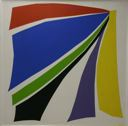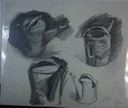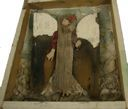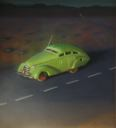Edith Taylor Roberson does not have an image.
Edith Taylor Roberson
(Salt Lake City, Utah, 1929 - 2014, Salt Lake City, Utah )
Edie Roberson was born on February 18, 1929, in Wilmington, Delaware. Roberson studied at the Pennsylvania Academy of Fine Arts and later with Charles McClelland, a student of Howard Pyle. In 1960, she moved to Utah, where she immediately became active in local exhibitions and had two solo shows at the Salt Lake Art Center. Since that time, Edie Roberson has become one of the state's most important imaginative and visionary artists. Roberson believes art is a vital method of communication, and her artwork is intended as personal statements. Her work has been described as eclectic (made up of various sources) and as Magic Realism. She describes herself as a Super-Realist who likes to get close enough and deep enough to explore every surface and detail, taking small objects and painting them in large scale. Channel Three, like many of her artworks, is a trompe l'oeil (French term for "fool-the-eye") painting. Roberson has a wide a range of subjects, techniques, and styles. Her works vary from trompe l'oeil to direct landscape painting, and she works in many different media including acrylic, oil, pastel, and watercolor. Found objects and manufactured items such as dolls, toys, and postcards play a significant role in her works. These objects and their arrangements convey her feelings about the passage of time. According to Robert Olpin, "[Her] mastery of medium is thorough but purely for purposes of expressing deeply held feelings regarding the world's things." About her work Roberson says, "The subject matter for my paintings is chosen intuitively from all kinds of objects I've collected through the years. . . old rusty bicycles, dolls, miniatures, toys, and objects like marbles and feathers. Each has a special history whether known or unknown, and when they come together in different ways, they tell a story. They're like symbols in a dream." Roberson is careful to leave room for viewers to make up their own stories from the objects she puts in her pieces. In Edie Roberson, Utah inherited one of its most significant intellectual and philosophical artists. Robert Olpin notes, "[She has] a rather romantic interest in the lives surrounding and shaping and touching the surfaces of inanimate objects." Channel Three is her painting of a cork bulletin board complete with thumbnailed or stapled notes, cards, photos, and drawing cutouts, etc. As a trompe l'oeil, it deceives the viewer into thinking the objects in the painting are real and not merely represented. This works particularly well with this painting because the painting is on the same plane and the same scale as an actual bulletin board. The title Channel Three is not representative of what the painting is and yet, neither is this a bulletin board; it is a painting. In addition, the title refers to the surrealist notion of channeling responses, which leads the viewer to question realities, as in the floating jellybeans. The artist makes viewers want to touch the painting because mere eyes cannot be trusted. However, the Museum rule is: "You can look but you must not touch!"
(Salt Lake City, Utah, 1929 - 2014, Salt Lake City, Utah )
Edie Roberson was born on February 18, 1929, in Wilmington, Delaware. Roberson studied at the Pennsylvania Academy of Fine Arts and later with Charles McClelland, a student of Howard Pyle. In 1960, she moved to Utah, where she immediately became active in local exhibitions and had two solo shows at the Salt Lake Art Center. Since that time, Edie Roberson has become one of the state's most important imaginative and visionary artists. Roberson believes art is a vital method of communication, and her artwork is intended as personal statements. Her work has been described as eclectic (made up of various sources) and as Magic Realism. She describes herself as a Super-Realist who likes to get close enough and deep enough to explore every surface and detail, taking small objects and painting them in large scale. Channel Three, like many of her artworks, is a trompe l'oeil (French term for "fool-the-eye") painting. Roberson has a wide a range of subjects, techniques, and styles. Her works vary from trompe l'oeil to direct landscape painting, and she works in many different media including acrylic, oil, pastel, and watercolor. Found objects and manufactured items such as dolls, toys, and postcards play a significant role in her works. These objects and their arrangements convey her feelings about the passage of time. According to Robert Olpin, "[Her] mastery of medium is thorough but purely for purposes of expressing deeply held feelings regarding the world's things." About her work Roberson says, "The subject matter for my paintings is chosen intuitively from all kinds of objects I've collected through the years. . . old rusty bicycles, dolls, miniatures, toys, and objects like marbles and feathers. Each has a special history whether known or unknown, and when they come together in different ways, they tell a story. They're like symbols in a dream." Roberson is careful to leave room for viewers to make up their own stories from the objects she puts in her pieces. In Edie Roberson, Utah inherited one of its most significant intellectual and philosophical artists. Robert Olpin notes, "[She has] a rather romantic interest in the lives surrounding and shaping and touching the surfaces of inanimate objects." Channel Three is her painting of a cork bulletin board complete with thumbnailed or stapled notes, cards, photos, and drawing cutouts, etc. As a trompe l'oeil, it deceives the viewer into thinking the objects in the painting are real and not merely represented. This works particularly well with this painting because the painting is on the same plane and the same scale as an actual bulletin board. The title Channel Three is not representative of what the painting is and yet, neither is this a bulletin board; it is a painting. In addition, the title refers to the surrealist notion of channeling responses, which leads the viewer to question realities, as in the floating jellybeans. The artist makes viewers want to touch the painting because mere eyes cannot be trusted. However, the Museum rule is: "You can look but you must not touch!"










